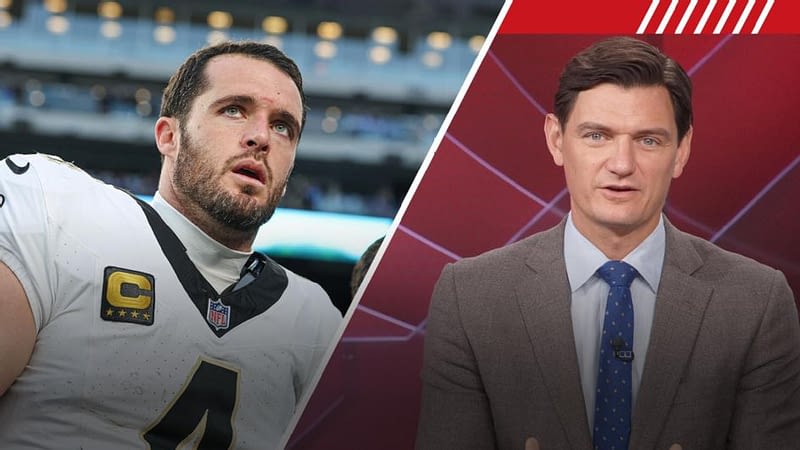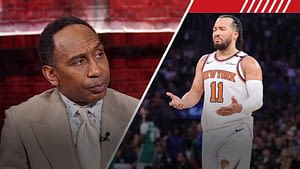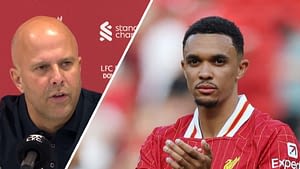Saints Quarterback Derek Carr Announces Retirement: What’s Next for New Orleans?
In a move that has sent ripples through the NFL community, Saints quarterback Derek Carr announced his retirement from the NFL on Saturday. While the news was surprising, it wasn’t entirely unexpected. During offseason training, Carr discovered a throwing shoulder injury that would have required surgery, prompting him to step away from football at the age of 34.
The Saints, however, seem to be in a unique position to handle Carr’s departure. They were already planning to move on from him in 2026 due to financial considerations and had been considering future quarterbacks this offseason. Carr’s injury merely accelerated their plans to find a young quarterback to fill his shoes. With Carr’s status uncertain during the NFL draft last month, the Saints selected Louisville quarterback Tyler Shough with the 40th pick.
With Carr’s retirement, the path is now clear for Shough to potentially win the starting job. However, coach Kellen Moore has announced an open competition between Shough, Spencer Rattler, and Jake Haener for the position. Neither Rattler nor Haener were drafted by the current coaching staff, and neither were selected as high as Shough. Both have had starting opportunities but didn’t perform well enough to prevent the selection of Shough. The rookie is undoubtedly in the lead for the starting role, assuming this is a genuine competition. If Shough secures the position, he would be the first rookie quarterback selected outside of the first round to start his first career game since DeShone Kizer in 2017.
Shough, a seven-year collegiate player and four-year starter at Oregon, Texas Tech, and Louisville, was part of the 2018 recruiting class and is 25 years old. By midseason of his rookie year, he’ll be 26, making him two years older than Rattler and only a few months younger than Haener.
Shough’s age suggests a certain level of pro readiness, which is promising for a Saints team now in need of a starter. However, due to Shough’s extensive injuries, he had only 951 pass attempts in college. Giants quarterback Jaxson Dart had 1,307, and Browns quarterback Shedeur Sanders had 907 in just two seasons with Colorado. Despite his age, Shough hasn’t seen much action.
But experience isn’t the only measure of pro readiness. While Shough hasn’t taken as many snaps as one might expect of a 25-year-old, he has been through numerous installs and offseason programs, working with various receivers and systems. It’s reasonable to expect more from Shough than the average rookie in terms of learning the playbook and commanding the locker room. We can anticipate him having more mature habits than a 21- or 22-year-old.
Shough’s final college stop was at Louisville, where coach Jeff Brohm’s offense further enhances his immediate projection as a Week 1 starter. Shough took some under-center dropbacks with the Cardinals (only 27, but that’s quite a bit compared to most college quarterbacks). Fewer than 10% of Shough’s pass attempts were screens, one of the lowest rates in the country. His film includes NFL concepts, like a deep play-action dropback with a high corner route on top of the crosser.
Tyler Shough throwing the high corner off play-action. Can’t drop it in the bucket much better than that. pic.twitter.com/WwImNydpmd
— Benjamin Solak (@BenjaminSolak) April 1, 2025
This play highlights Shough’s best trait: his impressive arm, especially on vertical throws. Shough can drop deep throws into challenging buckets, a crucial skill for starting NFL quarterbacks, especially on a team with one of the league’s top deep threats in Rashid Shaheed. With good 6-foot-5 height and the ability to throw on the move, Shough has access to a full range of passes, giving Moore a wide array of offensive concepts to work with.
Identifying the type of offense Moore wants to run is the challenging part. He has been an offensive coordinator for the past six seasons—four in Dallas with Dak Prescott, one in Los Angeles with Justin Herbert, and one in Philadelphia with Jalen Hurts. His offense evolved over time in Dallas and then changed to accommodate Herbert and Hurts, as well as the pass catchers and offensive lines available to him at each stop.
For instance, Moore lined his quarterback up under center more frequently over time in Dallas but largely abandoned it with the Chargers and Eagles. His screen use varied, spiking during his season with the Chargers and dropping back down in Philadelphia. He had one season with a remarkable amount of empty sets (2021 in Dallas), one season that was run-heavy (unsurprisingly, 2024 in Philadelphia), and one season heavily reliant on pre-snap motion (2023 in Los Angeles, though he generally used more motion than the average coordinator).
What does Moore want to do in New Orleans, especially now that he’s the head coach and not just the offensive coordinator? He will adjust his offense to the tools available to him, but Shough has never taken an NFL snap. When the slate is almost completely blank, it’s hard to adjust the scheme to existing expectations.
Let’s step away from the quarterback and look at the resources. With an excellent pass-catching back in Alvin Kamara, it’s reasonable to think the Saints will be screen-heavy (and generally more pass-heavy). A Kamara checkdown is as dangerous and valuable as any in the league. Except for the Eagles in 2024, who were predictably run-heavy, Moore’s teams have generally skewed towards passing.
But it might not make sense for the rest of the team. The Saints lack size and tackle-breaking ability at receiver, but Shaheed and Chris Olave are two agile route runners who can win downfield. The tight end room in New Orleans is quite deep, with Juwan Johnson (who just got a nice extension), Foster Moreau, and Taysom Hill. Last season, the Saints found success with a two-wide-receiver, two-tight-end offense before injuries hit Shaheed, Olave, Carr, and multiple interior offensive linemen. Expect those multiple-tight-end sets to be a significant part of the offense again.
It would be ideal to rely on those deep play-action dropbacks with Olave and Shaheed sprinting downfield, as the Saints did last season. But a threatening running game is necessary to build a passing menu out of play-action passes. How the Saints choose to run the ball is a fascinating question. Moore has been in both zone-heavy and gap-heavy offenses and has operated with the QB both under center and in the gun. From Philadelphia, he brought run game coordinator T.J. Paganetti, a longtime Jeff Stoutland assistant. The Eagles run every concept under the sun. Shough has enough mobility to occasionally include himself in the QB run game, but he won’t dominate touches like Hurts does in Philadelphia.
The Saints’ offensive line thrived on zone runs last season under offensive coordinator Klint Kubiak, an extension of the Kyle Shanahan coaching tree. The Saints are expected to start two young tackles in second-year man Taliese Fuaga (expected to switch from the left side to the right side) and rookie first-rounder Kelvin Banks Jr. A heavy diet of runs and play-action passes would protect the green duo from as many true one-on-one pass sets as possible, which feels like a priority.
And, of course, Shough is a big part of the equation. It’s hard to ask a rookie passer to run a pass-happy approach. If Moore wants to spread formations out, get five into the concept, and move the ball in the quick game (as he largely did with Prescott in Dallas), he’d be putting extra helpings on Shough’s plate. As discussed earlier, it’s reasonable to expect Shough to be more pro-ready than the average rookie quarterback—but only to a point.
Shough is a fine quick-game thrower and appears to be a rhythm passer. He likes to tie concepts to the timing of his feet, and you can feel him get comfortable as he starts to string quick completions together. The concern is that Shough doesn’t have the fastest feet—he’s a taller, longer QB—and he isn’t a particularly sudden or flexible thrower. When throws don’t come out in rhythm, there can be significant moments of accuracy drain, especially if pressure is involved.
Take this checkdown against Clemson. A smaller, bouncier quarterback would more easily reset his throwing platform or sidearm this throw in, but Shough’s feet are heavy, and he isn’t a particularly elastic thrower. This ball sails.
— Good Clips (@MeshSitWheel) May 10, 2025
Shough has good snaps as a processor and distributor, but he’s not at the level of Prescott or Herbert there, and it will likely take him a couple of years to get there. How well he acclimates to NFL coverages and how quickly he operates against NFL throwing windows will define just how pass-happy Moore can get in New Orleans. In the short term, using Shough more as a moon-ball launcher behind a run-heavy philosophy—similar to Hurts in 2024—feels optimal.
Since Shough was a top-50 pick of the new coaching staff, the new system will likely be built with him in mind. However, it’s worth noting that Shough has one of the cardinal weaknesses that quickly undermine rookie quarterbacks—especially those forced into early action. He is extremely shaky around pressure.
Shough is a solid avoider of sacks, mainly because he has an extremely quick alarm system and bails early. Of the five quarterbacks taken in the first three rounds, Shough’s 8.6% sack rate when pressured is nearly half that of the next best (Cam Ward at 14.5%). But escaping sacks is only the first part of making plays under pressure; NFL quarterbacks must be able to throw from pockets muddied by penetration, accelerate their throwing process to beat an incoming hit, and make cool-headed decisions while under duress. Shough tends to fade away from hits, which dramatically impacts his accuracy, and will launch panic throws when he knows he’s going down.
The good news is that Shough won’t let hits accumulate because he’s so willing to throw the ball up to avoid a sack. The quickest way to ruin a rookie quarterback is to break him with contact. The bad news is that no matter what sort of offense Moore runs for him, Shough might put a hard cap on the ceiling of that offense if he’s only able to make big plays when his pocket is perfectly protected.
In Rattler’s six starts last season, there was plenty of worrying stuff—22 sacks and five interceptions—but he was willing to extend plays and create explosive gains when pressured. If a calmer and more accurate Rattler shows up to training camp this year, the 2024 fifth-rounder will push Shough for the starting job early. He has a more impressive arm and better movement skills.
1:00
Tyler Shough’s NFL draft profile
Check out Louisville QB Tyler Shough’s NFL draft résumé.
Expectations should always be tempered for a second-round rookie quarterback, especially on a team like the Saints that doesn’t have elite offensive personnel. But it’s doubly tough to predict how well Shough will play because we can’t really foresee what Moore will do with this offense schematically. While Moore has long adjusted his offense for the veteran quarterbacks he has inherited, there’s also a chance he runs his ideal offense and requires the rookie QB to adjust his game to it.
Shough does plenty well as a pocket passer and processor, so if the scheme is sound and the receivers are winning, this Saints operation has a chance of being much more functional than one might expect. But it also has a chance of being a disaster.
There aren’t many offenses with a wider range of outcomes than New Orleans, where the new coach and new quarterback hold all the cards.
Originally Written by: Ben Solak




















